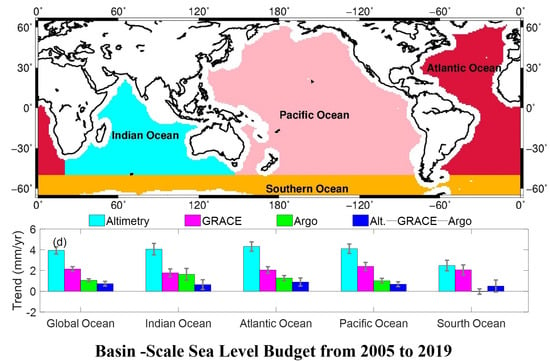Basin-Scale Sea Level Budget from Satellite Altimetry, Satellite Gravimetry, and Argo Data over 2005 to 2019
Abstract
1. Introduction
2. Data and Methodology
3. Results
3.1. Global and Basin-Scale Sea Level Budget
3.2. The Impact of Salinity Drift to Regional SLB
4. Conclusions
Author Contributions
Funding
Acknowledgments
Conflicts of Interest
References
- Cheng, L.; Abraham, J.; Zhu, J.; Trenberth, K.; Fasullo, J.; Boyer, T.; Locarnini, R.; Zhang, B.; Yu, F.; Wan, L.; et al. Record-Setting Ocean Warmth Continued in 2019. Adv. Atmos. Sci. 2020, 37, 137–142. [Google Scholar] [CrossRef]
- Abraham, J.P.; Baringer, M.; Bindoff, N.L.; Boyer, T.; Cheng, L.J.; Church, J.A.; Conroy, J.L.; Domingues, C.M.; Fasullo, J.T.; Gilson, J.; et al. A review of global ocean temperature observations: Implications for ocean heat content estimates and climate change. Rev. Geophys. 2013, 51, 450–483. [Google Scholar] [CrossRef]
- IPCC. Climate Change 2021:The Physical Science Basis; Masson-Delmotte, V., Zhai, P., Pirani, A., Connors, S.L., Péan, C., Berger, S., Caud, N., Chen, Y., Goldfarb, L., Gomis, M.I., et al., Eds.; Cambridge University Press: Cambridge, UK, 2021. [Google Scholar]
- Church, J.A.; White, N.J.; Konikow, L.F.; Domingues, C.M.; Cogley, J.G.; Rignot, E.; Gregory, J.M.; Broeke, M.R.v.d.; Monaghan, A.J.; Velicogna, I. Revisiting the Earth’s sea-level and energy budgets from 1961 to 2008. Geophys. Res. Lett. 2013, 40, 4066. [Google Scholar] [CrossRef]
- Horwath, M.; Gutknecht, B.D.; Cazenave, A.; Palanisamy, H.K.; Marti, F.; Marzeion, B.; Paul, F.; Le Bris, R.; Hogg, A.E.; Otosaka, I.; et al. Global sea-level budget and ocean-mass budget, with a focus on advanced data products and uncertainty characterisation. Earth Syst. Sci. Data 2022, 14, 411–447. [Google Scholar] [CrossRef]
- Dieng, H.B.; Cazenave, A.; Meyssignac, B.; Ablain, M. New estimate of the current rate of sea level rise from a sea level budget approach. Geophys. Res. Lett. 2017, 44, 3744–3751. [Google Scholar] [CrossRef]
- Chen, J.L.; Wilson, C.R.; Tapley, B.D. Contribution of ice sheet and mountain glacier melt to recent sea level rise. Nat. Geosci. 2015, 6, 549–552. [Google Scholar] [CrossRef]
- Piecuch, C.G.; Ponte, R.M. Mechanisms of interannual steric sea level variability. Geophys. Res. Lett. 2011, 38, L15605. [Google Scholar] [CrossRef]
- Muntjewerf, L.; Petrini, M.; Vizcaino, M.; Ernani da Silva, C.; Sellevold, R.; Scherrenberg, M.D.W.; Thayer-Calder, K.; Bradley, S.L.; Lenaerts, J.T.M.; Lipscomb, W.H.; et al. Greenland Ice Sheet Contribution to 21st Century Sea Level Rise as Simulated by the Coupled CESM2.1-CISM2.1. Geophys. Res. Lett. 2020, 47, e2019GL086836. [Google Scholar] [CrossRef]
- Kim, J.S.; Seo, K.W.; Jeon, T.; Chen, J.L.; Wilson, C.R. Missing Hydrological Contribution to Sea Level Rise. Geophys. Res. Lett. 2019, 46, 12049–12055. [Google Scholar] [CrossRef]
- Levitus, S.; Antonov, J.; Boyer, T. World ocean heat content and thermosteric sea level change (0–2000 m), 1955–2010. Geophys. Res. Lett. 2012, 39, L10603–L10607. [Google Scholar] [CrossRef]
- Volkov, D.L.; Lee, S.-K.; Landerer, F.W.; Lumpkin, R. Decade-long deep-ocean warming detected in the subtropical South Pacific. Geophys. Res. Lett. 2017, 44, 927–936. [Google Scholar] [CrossRef] [PubMed]
- Jevrejeva, S.; Matthews, A.; Slangen, A. The Twentieth-Century Sea Level Budget: Recent Progress and Challenges. Surv. Geophys. 2017, 38, 295–307. [Google Scholar] [CrossRef]
- Chambers, D.P.; Cazenave, A.; Champollion, N.; Dieng, H.; Llovel, W.; Forsberg, R.; von Schuckmann, K.; Wada, Y. Evaluation of the Global Mean Sea Level Budget between 1993 and 2014. Surv. Geophys. 2017, 38, 309–327. [Google Scholar] [CrossRef]
- WCRP Global Sea Level Budget Group. Global Sea Level Budget 1993-Present. Earth Syst. Sci. Data 2018, 10, 1551–1590. [Google Scholar] [CrossRef]
- Dieng, H.B.; Palanisamy, H.; Cazenave, A.; Meyssignac, B.; von Schuckmann, K. The Sea Level Budget Since 2003: Inference on the Deep Ocean Heat Content. Surv. Geophys. 2015, 36, 209–229. [Google Scholar] [CrossRef]
- Dieng, H.B.; Cazenave, A.; von Schuckmann, K.; Ablain, M.; Meyssignac, B. Sea level budget over 2005–2013: Missing contributions and data errors. Ocean. Sci. 2015, 11, 789–802. [Google Scholar] [CrossRef]
- Yang, Y.; Zhong, M.; Feng, W.; Mu, D. Detecting Regional Deep Ocean Warming below 2000 Meter Based on Altimetry,GRACE,Argo,and CTD Data. Adv. Atmos. Sci. 2021, 38, 13. [Google Scholar] [CrossRef]
- Llovel, W.; Willis, J.K.; Landerer, F.W.; Fukumori, I. Deep-ocean contribution to sea level and energy budget not detectable over the past decade. Nat. Clim. Chang. 2014, 4, 1031–1035. [Google Scholar] [CrossRef]
- Frederikse, T.; Landerer, F.; Caron, L.; Adhikari, S.; Parkes, D.; Humphrey, V.W.; Dangendorf, S.; Hogarth, P.; Zanna, L.; Cheng, L.; et al. The causes of sea-level rise since 1900. Nature 2020, 584, 393–397. [Google Scholar] [CrossRef]
- Royston, S.; Dutt Vishwakarma, B.; Westaway, R.; Rougier, J.; Sha, Z.; Bamber, J. Can We Resolve the Basin-Scale Sea Level Trend Budget From GRACE Ocean Mass? J. Geophys. Res. Ocean. 2020, 125, e2019JC015535. [Google Scholar] [CrossRef]
- Chen, J.; Tapley, B.; Wilson, C.; Cazenave, A.; Seo, K.-W.; Kim, J.-S. Global Ocean Mass Change From GRACE and GRACE Follow-On and Altimeter and Argo Measurements. Geophys. Res. Lett. 2020, 47, e2020GL090656. [Google Scholar] [CrossRef]
- Barnoud, A.; Pfeffer, J.; Guérou, A.; Frery, M.-L.; Siméon, M.; Cazenave, A.; Chen, J.; Llovel, W.; Thierry, V.; Legeais, J.-F.; et al. Contributions of Altimetry and Argo to Non-Closure of the Global Mean Sea Level Budget Since 2016. Geophys. Res. Lett. 2021, 48, e2021GL092824. [Google Scholar] [CrossRef]
- Vishwakarma, B.D.; Royston, S.; Riva, R.E.M.; Westaway, R.M.; Bamber, J.L. Sea Level Budgets Should Account for Ocean Bottom Deformation. Geophys. Res. Lett. 2020, 47, e2019GL086492. [Google Scholar] [CrossRef] [PubMed]
- Simon, K.M.; Riva, R.E.M. Uncertainty Estimation in Regional Models of Long-Term GIA Uplift and Sea-level Change: An Overview. J. Geophys. Res. Solid Earth 2020, 125, e2019JB018983. [Google Scholar] [CrossRef]
- Peltier, W.R.; Argus, D.F.; Drummond, R. Comment on “An Assessment of the ICE-6G_C (VM5a) Glacial Isostatic Adjustment Model” by Purcell et al. J. Geophys. Res. Solid Earth 2018, 123, 2019–2028. [Google Scholar] [CrossRef]
- Geruo, G.; Wahr, J.; Zhong, S. Computations of the viscoelastic response of a 3-D compressible Earth to surface loading: An application to Glacial Isostatic Adjustment in Antarctica and Canada. Geophys. J. Int. 2013, 192, 557–572. [Google Scholar] [CrossRef]
- Leuliette, E.; Willis, J. Balancing the Sea Level Budget. Oceanography 2011, 24, 122–129. [Google Scholar] [CrossRef]
- García-García, D.; Chao, B.; RÃ o, J.; Vigo, I.; Lafuente, J. On the steric and mass-induced contributions to the annual sea level variations in the Mediterranean Sea. J. Geophys. Res. 2006, 111, C09030. [Google Scholar] [CrossRef]
- Uebbing, B.; Kusche, J.; Rietbroek, R.; Landerer, F.W. Processing choices affect ocean mass estimates from GRACE. J. Geophys. Res. Ocean. 2019, 124, 1029–1044. [Google Scholar] [CrossRef]
- Cheng, M.; Ries, J. The unexpected signal in GRACE estimates of C20. J. Geod. 2017, 91, 897–914. [Google Scholar] [CrossRef]
- Sun, Y.; Riva, R.; Ditmar, P. Optimizing estimates of annual variations and trends in geocenter motion and J2 from a combination of GRACE data and geophysical models. J. Geophys. Res. Solid Earth 2016, 121, 8352–8370. [Google Scholar] [CrossRef]
- Swenson, S.; Chambers, D.; Wahr, J. Estimating geocenter variations from a combination of GRACE and ocean model output. J. Geophys. Res. 2008, 113, B08410. [Google Scholar] [CrossRef]
- Johnson, G.C.; Chambers, D.P. Ocean bottom pressure seasonal cycles and decadal trends from GRACE Release-05: Ocean circulation implications. J. Geophys. Res. Ocean. 2013, 118, 4228–4240. [Google Scholar] [CrossRef]
- Save, H.; Bettadpur, S.; Tapley, B.D. High resolution CSR GRACE RL05 mascons. J. Geophys. Res. Solid Earth 2015, 121, 7547–7569. [Google Scholar] [CrossRef]
- Mu, D.P.; Xu, T.H.; Xu, G.C. Detecting coastal ocean mass variations with GRACE mascons. Geophys. J. Int. 2019, 217, 2071–2080. [Google Scholar] [CrossRef]
- Li, H.; Xu, F.; Zhou, W.; Wang, D.; Wright, J.; Liu, Z.; Lin, Y. Development of a global gridded Argo data set with Barnes successive corrections. J. Geophys. Res. Ocean. 2017, 122, 866–889. [Google Scholar] [CrossRef]
- Cabanes, C.; Grouazel, A.; von Schuckmann, K.; Hamon, M.; Turpin, V.; Coatanoan, C.; Paris, F.; Guinehut, S.; Boone, C.; Ferry, N. The CORA dataset: Validation and diagnostics of in-situ ocean temperature and salinity measurements. Ocean. Sci. 2013, 9, 1–18. [Google Scholar] [CrossRef]
- Good, S.A.; Martin, M.J.; Rayner, N.A. EN4: Quality controlled ocean temperature and salinity profiles and monthly objective analyses with uncertainty estimates. J. Geophys. Res. Ocean. 2013, 118, 6704–6716. [Google Scholar] [CrossRef]
- Gouretski, V.; Reseghetti, F. On depth and temperature biases in bathythermograph data: Development of a new correction scheme based on analysis of a global ocean database. Deep.-Sea Res. Part I Oceanogr. Res. Pap. 2010, 57, 812–833. [Google Scholar] [CrossRef]
- Levitus, S.; Antonov, J.I.; Boyer, T.P.; Locarnini, R.A.; Garcia, H.E.; Mishonov, A.V. Global ocean heat content 1955-2008 in light of recently revealed instrumentation problems. Geophys. Res. Lett. 2009, 36, L07608. [Google Scholar] [CrossRef]
- Cheng, L.; Trenberth, K.E.; Fasullo, J.; Boyer, T.; Abraham, J.; Zhu, J. Improved estimates of ocean heat content from 1960 to 2015. Sci. Adv. 2017, 3, e1601545. [Google Scholar] [CrossRef] [PubMed]
- Hosoda, S.; Ohira, T.; Sato, K.; Suga, T. Improved description of global mixed-layer depth using Argo profiling floats. J. Oceanogr. 2010, 66, 773–787. [Google Scholar] [CrossRef]
- Roemmich, D.; Gilson, J. The 2004–2008 mean and annual cycle of temperature, salinity, and steric height in the global ocean from the Argo Program. Prog. Oceanogr. 2009, 82, 81–100. [Google Scholar] [CrossRef]
- Liu, C.; Liang, X.; Ponte, R.M.; Vinogradova, N.; Wang, O. Vertical redistribution of salt and layered changes in global ocean salinity. Nat. Commun. 2019, 10, 3445. [Google Scholar] [CrossRef] [PubMed]
- Wang, G.; Cheng, L.; Boyer, T.; Li, C. Halosteric Sea Level Changes during the Argo Era. Water 2017, 9, 484. [Google Scholar] [CrossRef]
- Blazquez, A.; Meyssignac, B.; Lemoine, J.-M.; Ribes, A.; Berthier, E.; Cazenave, A. Exploring the uncertainty in GRACE estimates of the mass redistributions at the Earth surface: Implications for the global water and sea level budgets. Geophys. J. Int. 2018, 215, 415–430. [Google Scholar] [CrossRef]
- Han, S.-C.; Shum, C.K.; Bevis, M.; Ji, C.; Kuo, C.Y. Crustal Dilatation Observed by GRACE After the 2004 Sumatra-Andaman Earthquake. Science 2006, 313, 658–662. [Google Scholar] [CrossRef]
- Han, S.-C.; Sauber, J.; Luthcke, S. Regional gravity decrease after the 2010 Maule (Chile) earthquake indicates large-scale mass redistribution. Geophys. Res. Lett. 2010, 37, L23307. [Google Scholar] [CrossRef]
- Han, S.-C.; Sauber, J.; Riva, R. Contribution of satellite gravimetry to understanding seismic source processes of the 2011 Tohoku-Oki earthquake. Geophys. Res. Lett. 2011, 38, L24312. [Google Scholar] [CrossRef]
- Piecuch, C.G.; Quinn, K.J. El Niño, La Niña, and the global sea level budget. Ocean. Sci. Discuss. 2016, 12, 1165–1177. [Google Scholar] [CrossRef]
- Yi, S.; Sun, W.K.; Heki, K.; Qian, A. An increase in the rate of global mean sea level rise since 2010. Geophys. Res. Lett. 2015, 42, 3998–4006. [Google Scholar] [CrossRef]
- Tiwari, V.M.; Cabanes, C.; DoMinh, K.; Cazenave, A. Correlation of interannual sea level variations in the Indian Ocean from Topex/Poseidon altimetry, temperature data and tide gauges with ENSO. Glob. Planet. Chang. 2004, 43, 183–196. [Google Scholar] [CrossRef]
- Piecuch, C.G.; Ponte, R.M. Mechanisms of Global-Mean Steric Sea Level Change. J. Clim. 2014, 27, 824–834. [Google Scholar] [CrossRef]
- Llovel, W.; Lee, T. Importance and origin of halosteric contribution to sea level change in the southeast Indian Ocean during 2005–2013. Geophys. Res. Lett. 2015, 42, 1148–1157. [Google Scholar] [CrossRef]
- Wang, X.D.; Han, G.J.; Li, W.; Wu, X.R.; Zhang, X.F. Salinity drift of global Argo profiles and recent halosteric sea level variation. Glob. Planet. Chang. 2013, 108, 42–55. [Google Scholar] [CrossRef]
- Romero, E.; Tenorio-Fernandez, L.; Castro, I.; Castro, M. Filtering method based on cluster analysis to avoid salinity drifts and recover Argo data in less time. Ocean. Sci. 2021, 17, 1273–1284. [Google Scholar] [CrossRef]
- Bordone, A.; Pennecchi, F.; Raiteri, G.; Repetti, L.; Reseghetti, F. XBT, ARGO Float and Ship-Based CTD Profiles Intercompared under Strict Space-Time Conditions in the Mediterranean Sea: Assessment of Metrological Comparability. J. Mar. Sci. Eng. 2020, 8, 313. [Google Scholar] [CrossRef]
- Camargo, C.M.L.; Riva, R.E.M.; Hermans, T.H.J.; Slangen, A.B.A. Exploring Sources of Uncertainty in Steric Sea-Level Change Estimates. J. Geophys. Res. Ocean. 2020, 125, e2020JC016551. [Google Scholar] [CrossRef]
- Llovel, W.; Purkey, S.; Meyssignac, B.; Blazquez, A.; Kolodziejczyk, N.; Bamber, J. Global ocean freshening, ocean mass increase and global mean sea level rise over 2005–2015. Sci. Rep. 2019, 9, 17717. [Google Scholar] [CrossRef]
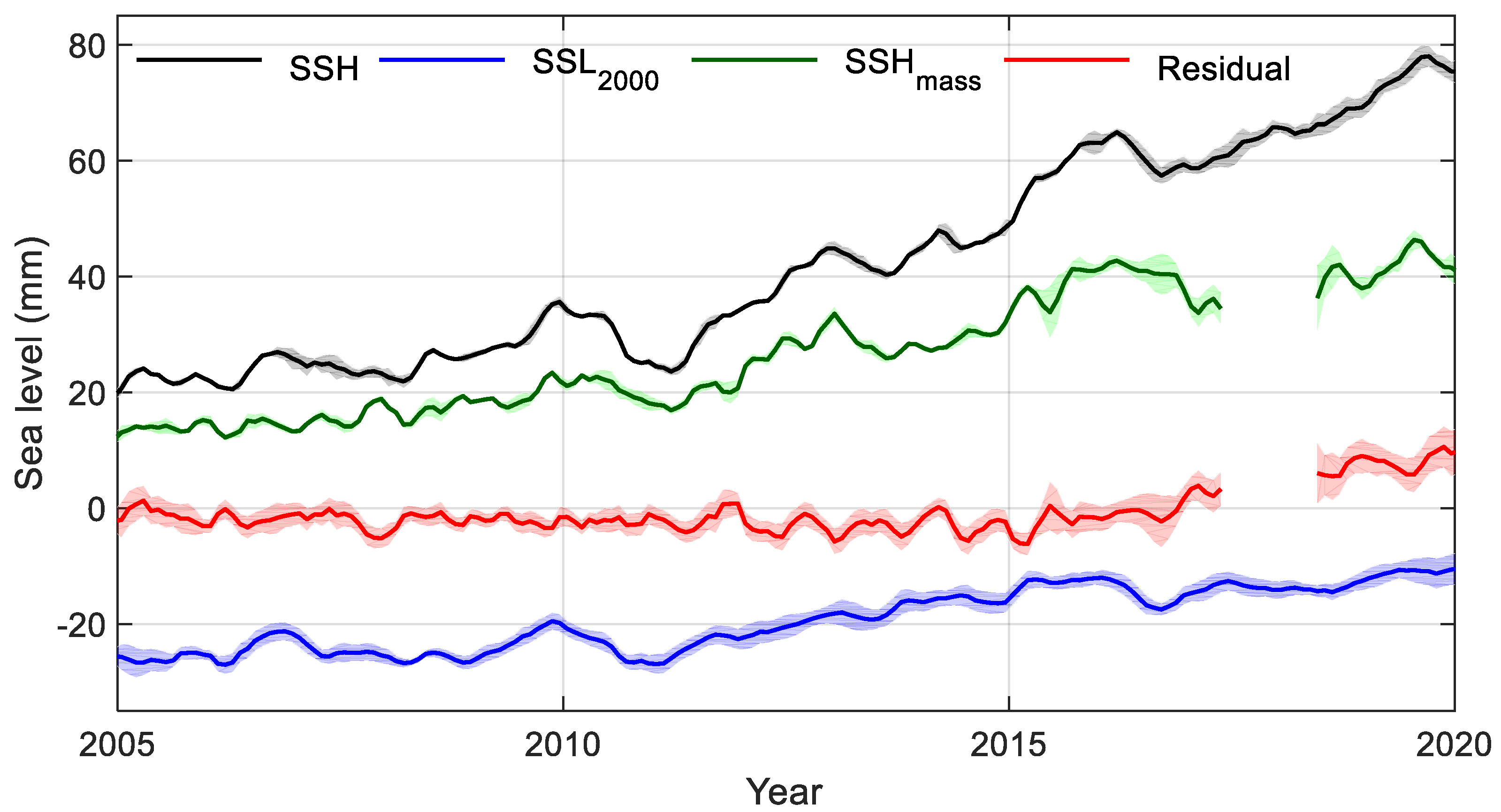
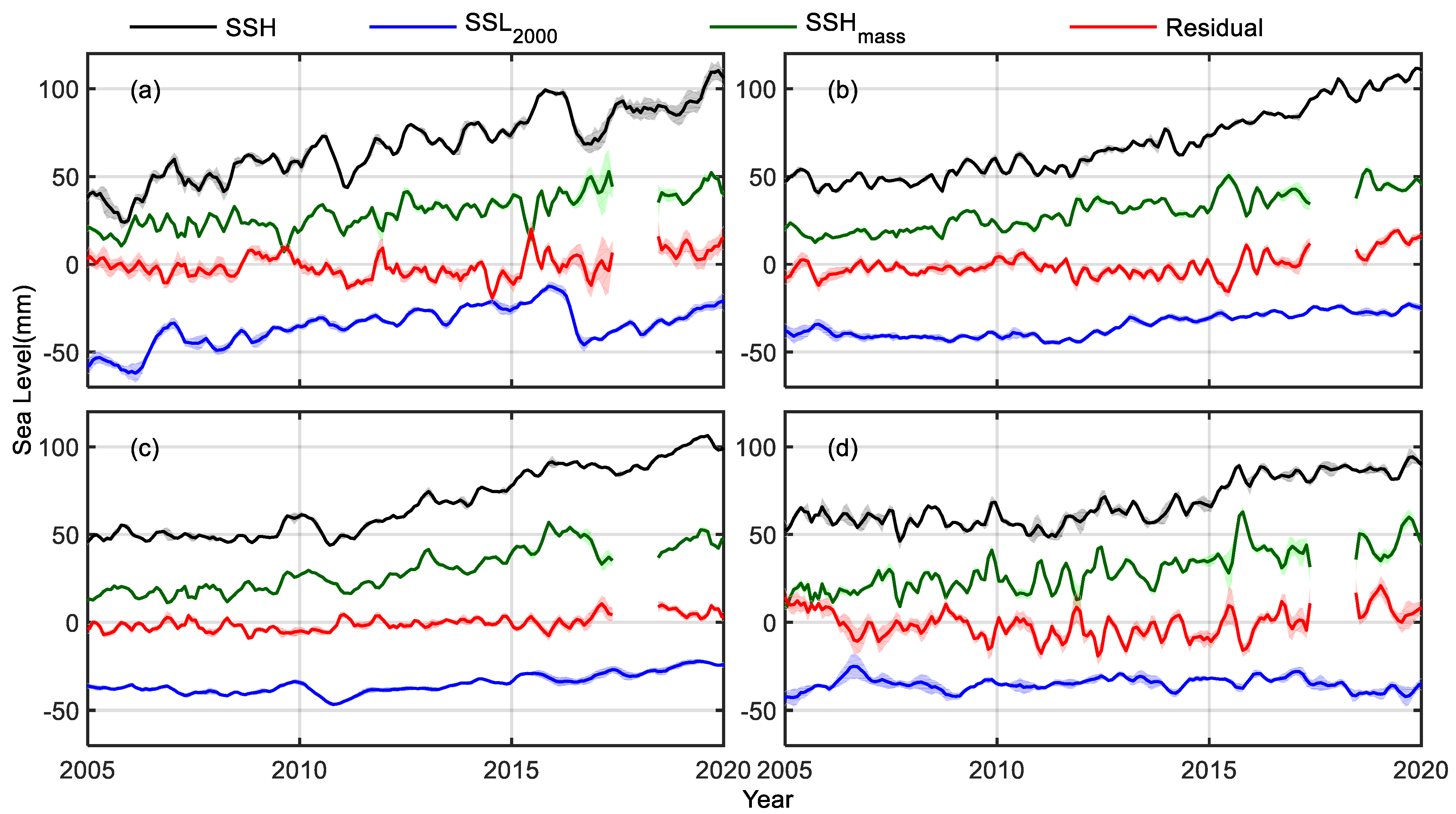
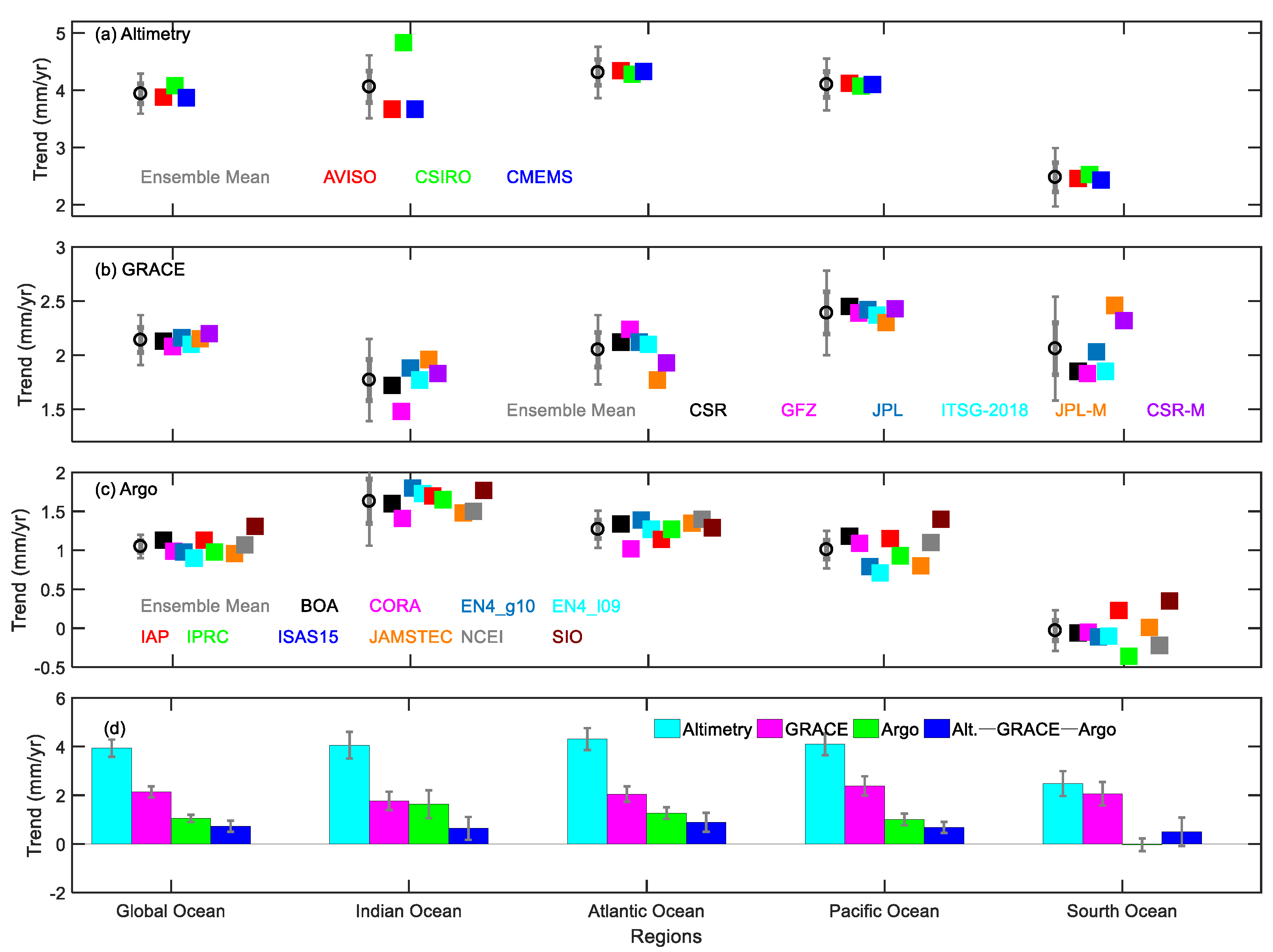
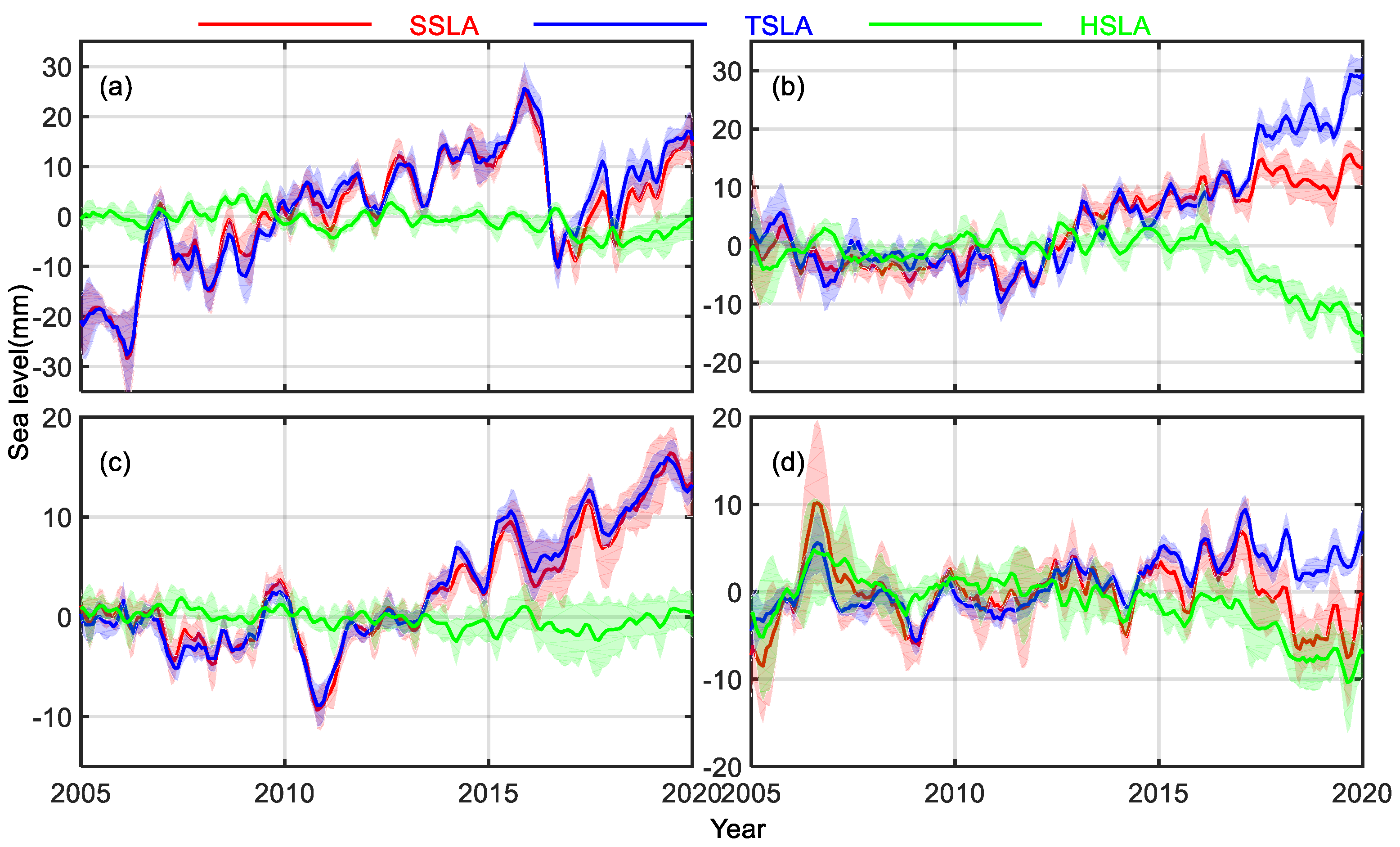

| Index | Dataset | Horizontal Resolution | Vertical Resolution | Data Source | Reference |
|---|---|---|---|---|---|
| 1 | BOA | 1° × 1° | 0–1975 dbar, 58 layers | Argo | [37] |
| 2 | CORA | 1/2° (Mercator) | 1–2000 m, 152 layers | Argo + others | [38] |
| 3 | EN4_g10 | 1° × 1° | 5–5350 m, 42 layers | Argo + others | [39,40] |
| 4 | EN4_L09 | 1° × 1° | 5–5350 m, 42 layers | Argo + others | [39,41] |
| 5 | IAP | 1° × 1° | 0–2000 m, 41 layers | Argo + others | [42] |
| 6 | IPRC | 1° × 1° | 0–2000 m, 27 layers | Argo + others | http://apdrc.soest.hawaii.edu/ (accessed on 2 August 2022) |
| 7 | JAMSTEC | 1° × 1° | 10–2000 dbar, 25 layers | Argo + others | [43] |
| 8 | NCEI | 1° × 1° | 0–5500 m, 102 layers | Argo + others | [11] |
| 9 | SIO | 1° × 1° | 2.5–1975 dbar, 58 layers | Argo | [44] |
| Indian | Atlantic | Pacific | Southern Ocean | Global Ocean | |||||||
|---|---|---|---|---|---|---|---|---|---|---|---|
| Altimetry | |||||||||||
| Mean Trend | ±s.e. | 4.06 | 0.28 | 4.31 | 0.23 | 4.10 | 0.23 | 2.48 | 0.26 | 3.94 | 0.18 |
| ensemble spread | 0.67 | 0.03 | 0.03 | 0.05 | 0.12 | ||||||
| orbital altitude | 0.20 | 0.22 | 0.58 | 0.13 | 0.13 | ||||||
| OBD | 0.16 | 0.16 | 0.16 | 0.16 | 0.16 | ||||||
| Quadratic sum of uncertainties | 0.77 | 0.36 | 0.64 | 0.34 | 0.3 | ||||||
| Argo | |||||||||||
| Mean Trend | ±s.e. | 1.63 | 0.29 | 1.27 | 0.12 | 1.01 | 0.12 | −0.03 | 0.13 | 1.05 | 0.08 |
| ensemble spread | 0.14 | 0.12 | 0.22 | 0.22 | 0.12 | ||||||
| Quadratic sum of uncertainties | 0.32 | 0.17 | 0.25 | 0.26 | 0.14 | ||||||
| GRACE | |||||||||||
| Mean Trend | ±s.e. | 1.77 | 0.19 | 2.05 | 0.16 | 2.39 | 0.20 | 2.06 | 0.24 | 2.14 | 0.12 |
| ensemble spread | 0.17 | 0.17 | 0.05 | 0.27 | 0.04 | ||||||
| degree1 spread | 0.60 | 0.22 | 0.06 | 1.05 | 0.2 | ||||||
| C20 spread | 0.11 | 0.08 | 0.13 | 0.37 | 0.06 | ||||||
| GIA spread | 0.16 | 0.03 | 0.05 | 0.30 | 0.02 | ||||||
| filter spread | 0.06 | 0.09 | 0.02 | 0.15 | 0.03 | ||||||
| Quadratic sum of uncertainties | 0.68 | 0.34 | 0.26 | 1.22 | 0.25 | ||||||
| Alt.–GRACE–Argo | 0.66 | 1.08 | 0.99 | 0.52 | 0.7 | 0.74 | 0.45 | 1.29 | 0.75 | 0.41 | |
| Time | Indian | Atlantic | Pacific | Southern Ocean | Global Ocean |
|---|---|---|---|---|---|
| HSLA (2005–2015) | −0.13 ± 0.18 | 0.29 ± 0.17 | −0.15 ± 0.06 | −0.21 ± 0.21 | −0.05 ± 0.07 |
| HSLA (2005–2019) | −0.30 ± 0.12 | −0.47 ± 0.26 | −0.10 ± 0.04 | −0.51 ± 0.16 | −0.25 ± 0.07 |
| Salinity drift | 0.17 | 0.76 | 0.05 | 0.3 | 0.2 |
| Revised residual trends from 2005 to 2019 | 0.49 ± 1.08 | 0.23 ± 0.52 | 0.65 ± 0.74 | 0.15 ± 1.29 | 0.55 ± 0.41 |
Publisher’s Note: MDPI stays neutral with regard to jurisdictional claims in published maps and institutional affiliations. |
© 2022 by the authors. Licensee MDPI, Basel, Switzerland. This article is an open access article distributed under the terms and conditions of the Creative Commons Attribution (CC BY) license (https://creativecommons.org/licenses/by/4.0/).
Share and Cite
Yang, Y.; Feng, W.; Zhong, M.; Mu, D.; Yao, Y. Basin-Scale Sea Level Budget from Satellite Altimetry, Satellite Gravimetry, and Argo Data over 2005 to 2019. Remote Sens. 2022, 14, 4637. https://doi.org/10.3390/rs14184637
Yang Y, Feng W, Zhong M, Mu D, Yao Y. Basin-Scale Sea Level Budget from Satellite Altimetry, Satellite Gravimetry, and Argo Data over 2005 to 2019. Remote Sensing. 2022; 14(18):4637. https://doi.org/10.3390/rs14184637
Chicago/Turabian StyleYang, Yuanyuan, Wei Feng, Min Zhong, Dapeng Mu, and Yanli Yao. 2022. "Basin-Scale Sea Level Budget from Satellite Altimetry, Satellite Gravimetry, and Argo Data over 2005 to 2019" Remote Sensing 14, no. 18: 4637. https://doi.org/10.3390/rs14184637
APA StyleYang, Y., Feng, W., Zhong, M., Mu, D., & Yao, Y. (2022). Basin-Scale Sea Level Budget from Satellite Altimetry, Satellite Gravimetry, and Argo Data over 2005 to 2019. Remote Sensing, 14(18), 4637. https://doi.org/10.3390/rs14184637





